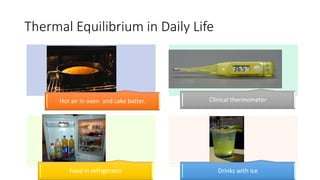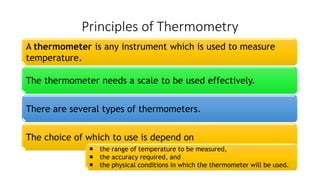Thermometer calibration
- 1. THERMOMETERS HEAT | PHYSICS FORM 4 What is thermometric property? How to calibrate a thermometer? What are the characteristics of a quality thermometer?
- 2. Thermal Equilibrium in Daily Life Clinical thermometer Drinks with ice Food in refrigerator Hot air in oven and cake batter.
- 3. What is temperature? The temperature of an object is a measure of the average kinetic energy of its particle. If a hot object is placed in contact with a cold one, there is a transfer of thermal energy from one to the other. When both objects reach the same temperature, the transfer of energy stops because the average per particle is the same in both.
- 4. Principles of Thermometry A thermometer is any instrument which is used to measure temperature. The thermometer needs a scale to be used effectively. There are several types of thermometers. The choice of which to use is depend on the range of temperature to be measured, the accuracy required, and the physical conditions in which the thermometer will be used.
- 6. To calibrate a Liquid-in glass thermometer using two fixed points A thermometer that does not have a scale can be calibrated using two fixed temperature points. melting point of ice, 0°C Boiling point of water, 100°C.
- 9. Discussion The bulb of the thermometer should not touch the base or side wall of the beaker while taking measurement. Explain.
- 10. Formula If the lengths of mercury thread at ice point (0 °C), at steam point (100 °C) and when immersed in a liquid of unknown temperature θ are l0, l100 and lθ respectively, the temperature θ can be calculated as follows:
- 11. Thermometric Properties Some materials have properties that changes with temperature: Liquids can expand if the temperature increases, or contract if it decreases; Metals and alloys also expand and contract if the temperature changes; Some substances change their colours when the temperature increases Some substances change their electrical conductivity when its temperature rises
- 12. Thermometer the bulb wall are usually made to be thin so that conduction of heat energy can occur as quickly as possible. the larger the bulb, the less responsive it is, since there is more liquid in the larger bulb. Responsiveness: How long it takes for the thermometer to react to a change in temperature
- 13. Thermometer Sensitivity: this measures the amount of change in thermometric property per unit change in temperature. a thermometer with a thicker bore will be less sensitive since the change in length of the thermometric liquid is lesser.
- 14. Thermometer This Photo by Unknown Author is licensed under CC BY-SA Range: refers to scope of temperature it can measure. the longer the length of the stem, the larger the range of the thermometer Capillary/bore thread Glass bulb
- 15. Thermometer Linearity: is the uniform expansion of the liquid to temperature which give the reading. mercury expand at a steady rate as it is heated.
- 16. Liquid-in-glass-thermometer • To allow conduction of heat quickly throughglass to the liquid Thin-wall glass bulb • Small amount of liquid responds more quickly to a change in temperature Small bulb • To allow noticeable movement of liquid • To ensure even expansion of liquid Fine and uniform bore • Act as magnifying glass for easy reading Thick-wall tube • More portable and cheap to produce Smaller size
- 17. Thermocouple thermometer The probe contains 2 different metals joined to form 2 junctions. The temperature difference causes a tiny voltage which makes a current flow. A greater temperature difference gives a greater current. Thermocouple thermometers are used for high temperatures which change rapidly and have a large range (-200C° to 1100°C)
- 18. Advantages of a thermocouple Thermocouple can operate over a very wide range of temperatures from −200 °C to 1700 °C. It can be used to measure high temperature. very wide range As the wire junctions are very small, the thermocouple can be used to measure the temperature at a point. Any point Due to small mass and small thermal capacity of the thermojunctions, the thermocouple can be used to measure temperatures that change rapidly. Change rapidly Thermocouple can operate over a very wide range of temperatures from −200 °C to 1700 °C. It can be used to measure high temperature. very wide range As the wire junctions are very small, the thermocouple can be used to measure the temperature at a point. Any point Due to small mass and small thermal capacity of the thermojunctions, the thermocouple can be used to measure temperatures that change rapidly. Change rapidly


















